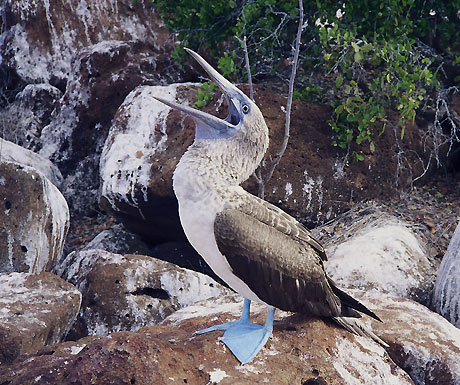In evolutionary theory, survival of the fittest doesnt capture the whole picture. As Charles Darwin pointed out, it is not brute strength alone that wins out in evolution but the ability of a species to adapt to change. Courtship matters. Attractiveness to mates is quite important for the passing along of well-adapted genes. The Galapagos Islands, where Darwin himself began forming his theory, is a veritable laboratory of evolution.

Here are five Galapagos species with elaborate courtship rituals that help them woo a mate and procreate.
1) The Blue-footed Booby shakes his feet
The Blue-footed Boobys webbed feet, an icon of the Galapagos Islands, come in many shades of blue. But what are they used for? How did the trait evolve? The male Boobie actually uses his bright feet to catch the eye of a lady Boobie and initiate one of the most famous mating dances on the islands.
During mating season, the male Boobie will groom himself to look his best. Then, when female Boobies are near, the seduction begins. Hell start flashing his feet, one at a time, while whistling and pointing to the sky with his beak and tail. Hell flair out his wings. He might even offer the female a twig. Will she buy this bizarre display? Yes, if the male Boobie is lucky (or if his feet happen to be a particularly lovely shade of blue).
2) Waved Albatrosses click their beaks and nod heads
Spectacular and endearing, the courtship dance of the Waved Albatross is like a holy grail of Galapagos wildlife viewing. Their habitat of black lava fields with sparse vegetation becomes the dance floor. Here, the male and female approach each other and begin to bow. Eyes fixed on each other, they thrust their heads from side to side.
Then the clacking begins. The Albatross couple will tap their beaks against each other, creating a tiny sound like the clicking of chopsticks. Pause. Theyll both throw open their beaks in what looks like a silent scream, then go in for another round of clacking. Tap-tap-tap-tap-tap. Theyre officially a couple.
3) Flightless Cormorants dance an aquatic waltz
Evolutionarily speaking, the Flightless Cormorant is best known for its wings. Mere vestiges of what were once useful flying mechanisms, the wings of the Cormorant are now only one third the size necessary for flight. Over evolutionary time, this species has adapted more to underwater fishing than airborne hunting.
A scruffy-winged Flightless Cormorant may not have good looks to attract the ladies, but he has all the right moves. In their special courtship ritual, the male and female glide out onto the water, where they circle around each other with their necks curved and craned. Once the male selects his mate, hell take her back on land to his seaweed nest, where gifts of flotsam and debris await.
4) Flamingos flaunt their finest wing feathers
In the Galapagos Islands, only one species of flamingos can be found. Elusive and small in numbers, they are limited to the islands of Floreana, Punta Moreno, and Cerro Dragon. Managing to get a glimpse of these rare birds is lucky. Even luckier is to catch them in their graceful mating ritual, which is considered to be one of natures most impressive displays.
For flamingos, courtship is a large group affair. During the mating season, theyll aggregate together, knee deep in their habitat of still water. Then theyll exhibit their primaries (the longest and best-kempt feathers of their wings). In a dance, they expose these pink and black feathers and crane their necks, stretching so as to come across as the tallest. Two by two, the group couples off and the alone time begins.
5) Sea Lions aggressively defend harems of females
The sea lion is a highly social species, yet their mating habits arent nearly as tender and relatable as some of their feathered counterparts on Galapagos Islands. The females and pups are known for their uninhibited and friendly nature, even toward humans. But the males, or bulls, get aggressive and territorial when it comes to their heap of mates.
Sea lions organize themselves into harems of five to 25 females that are dominated by one bull. Each bull has to struggle and fight in order to keep his alpha status, but it will only last a couple months at most. The scars seen on a sea lions neck are from the battles for king of the hill. Losers are chased off, leading to a surplus of bachelor bulls that form peaceable but foul-smelling colonies away from the harems. Maybe their habits are not so un-relatable after all.